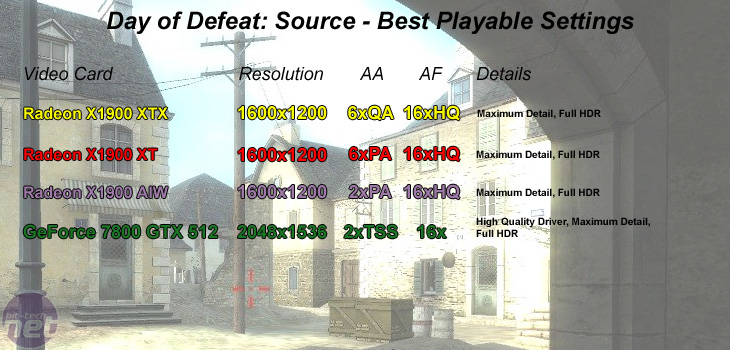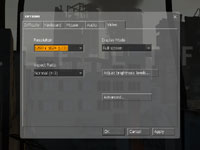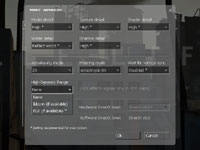
Day of Defeat: Source
Publisher: ValveWe used the popular remake of the World War II online multiplayer, Day of Defeat: Source, which uses Valve's implementation of high-dynamic range rendering. We did three five minute portions of real world game play on the dod_anzio map. We connected to three different public servers each with a ping of less than 30ms and 16-20 players in the game when we were recording the frame rates.
Anti-Aliasing and Anisotropic Filtering were controlled from inside the game, and thus the drivers were left set to "Application Controlled". There are three options for the method of HDR used in this title. You can either disable HDR completely, make use of "Bloom" which is just what it says and less resource hungry in comparison to "Full" which, again is just what it says. It utilises a full dynamic range with the iris effect too.
We have written quite a bit about Half-Life 2: Lost Coast, Day of Defeat: Source and how Valve have implemented HDR in to the Source Engine. You can check out the articles listed below for more information on The Lost Coast & Day of Defeat: Source.
- Half-Life 2: Lost Coast HDR overview
- Half-Life 2: Lost Coast hands on
- Half-Life 2: Lost Coast Benchmarks & Video
- Day of Defeat: Source
Below is a table of the best-playable settings that we found best for each video card configuration. We found that 25 frames per second is the required minimum, and a target of 45-50 frames per second (or higher) is the average frame rate in our manual run throughs on these mainstream video cards.


We found that 1600x1200 with 6xQAAA 16xHQ AF actually looked better than 2048x1536 2xQAAA 16xHQ AF and it proved to be completely playable on the Radeon X1900XTX. Despite the lower resolution, we felt that the image quality was much higher, as 6x QAAA is going to remove more aliased edges at 1600x1200 than 2x QAAA is going to do at 2048x1536, despite the higher density pixels.
With the Radeon X1900XT, we were able to experience smooth gameplay at the same settings as the Radeon X1900XTX, with performance adaptive antialiasing instead of quality adaptive antialiasing. In reality, that makes some very small differences to the image quality and you're not likely to notice them when you're deeply involved in a game of Day of Defeat.
The All-In-Wonder X1900 was playable at 1600x1200 2xPAAA 16xHQ AF with the in game details set to their highest settings. This wasn't quite as pleasing on the eye as the image quality delivered by the Radeon X1900XT or X1900XTX cards, but it was pretty good considering the price differential.

MSI MPG Velox 100R Chassis Review
October 14 2021 | 15:04







Want to comment? Please log in.